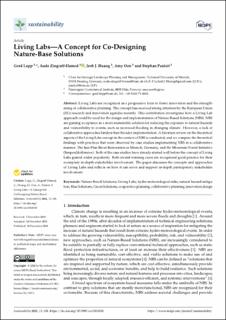| dc.description.abstract | Living Labs are recognized as a progressive form to foster innovation and the strengthening of collaborative planning. The concept has received strong attention by the European Union (EU) research and innovation agendas recently. This contribution investigates how a Living Lab approach could be used for the design and implementation of Nature-Based Solutions (NBS). NBS are gaining acceptance as a more sustainable solution for reducing the exposure to natural hazards and vulnerability to events, such as increased flooding in changing climate. However, a lack of collaborative approaches hinders their broader implementation. A literature review on the theoretical aspects of the Living Labs concept in the context of NBS is conducted, and we compare the theoretical findings with practices that were observed by case studies implementing NBS in a collaborative manner. The Isar-Plan River Restoration in Munich, Germany, and the Mountain Forest Initiative (Bergwaldoffensive). Both of the case studies have already started well before the concept of Living Labs gained wider popularity. Both award-winning cases are recognized good practice for their exemplary in-depth stakeholder involvement. The paper discusses the concepts and approaches of Living Labs and reflects on how it can serve and support in-depth participatory stakeholder involvement. | |
